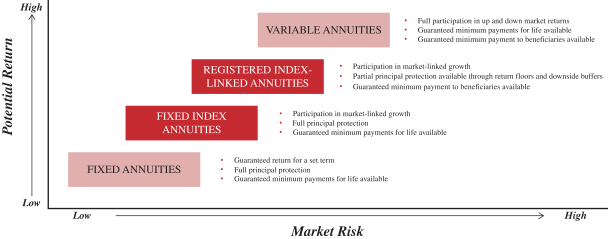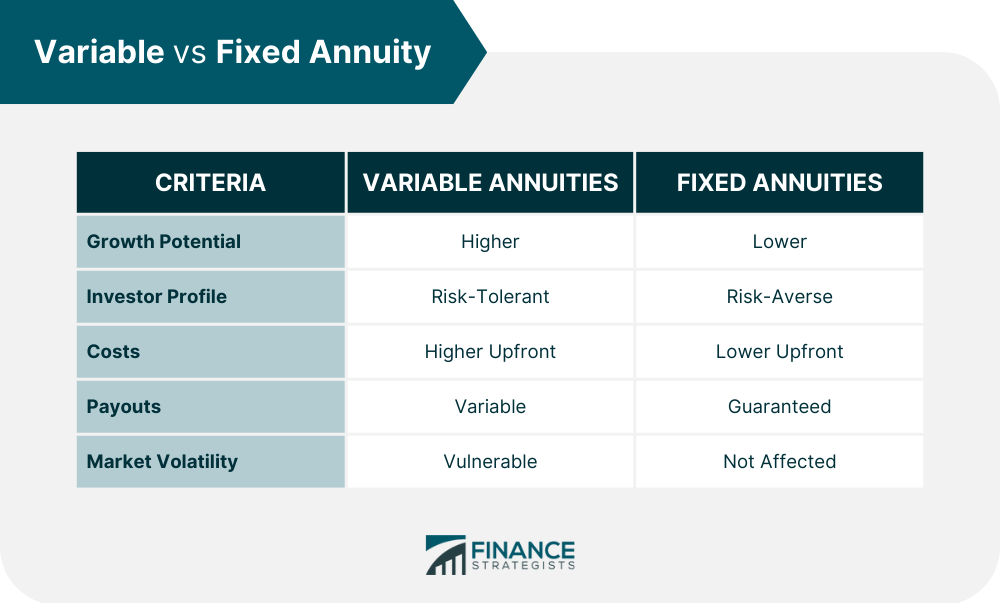All Categories
Featured
Table of Contents
The settlement may be spent for development for a long duration of timea single costs postponed annuityor invested for a short time, after which payout beginsa solitary premium instant annuity. Single premium annuities are commonly funded by rollovers or from the sale of an appreciated property. A versatile premium annuity is an annuity that is planned to be funded by a collection of repayments.
Proprietors of taken care of annuities know at the time of their acquisition what the worth of the future money flows will be that are created by the annuity. Clearly, the number of cash money flows can not be recognized in advance (as this depends upon the agreement owner's life-span), yet the guaranteed, fixed rate of interest a minimum of gives the owner some degree of assurance of future revenue from the annuity.
While this distinction seems easy and simple, it can substantially affect the value that an agreement owner inevitably originates from his/her annuity, and it develops substantial unpredictability for the agreement proprietor - Investment options in variable annuities. It also typically has a material impact on the degree of fees that a contract proprietor pays to the providing insurance policy business
Fixed annuities are typically utilized by older financiers who have actually restricted assets but who intend to balance out the danger of outlasting their possessions. Set annuities can offer as an efficient device for this objective, though not without particular drawbacks. In the instance of immediate annuities, when an agreement has been purchased, the contract proprietor gives up any kind of and all control over the annuity possessions.
Understanding Financial Strategies Key Insights on Your Financial Future Defining the Right Financial Strategy Pros and Cons of Various Financial Options Why Annuity Fixed Vs Variable Matters for Retirement Planning How to Compare Different Investment Plans: Explained in Detail Key Differences Between Different Financial Strategies Understanding the Risks of Long-Term Investments Who Should Consider Strategic Financial Planning? Tips for Choosing Fixed Vs Variable Annuity Pros Cons FAQs About Planning Your Financial Future Common Mistakes to Avoid When Choosing a Financial Strategy Financial Planning Simplified: Understanding Fixed Vs Variable Annuity Pros And Cons A Beginner’s Guide to Smart Investment Decisions A Closer Look at How to Build a Retirement Plan
A contract with a normal 10-year surrender duration would certainly bill a 10% abandonment fee if the contract was surrendered in the initial year, a 9% surrender fee in the 2nd year, and so on up until the abandonment cost reaches 0% in the agreement's 11th year. Some delayed annuity agreements consist of language that enables small withdrawals to be made at different periods during the abandonment duration scot-free, though these allocations generally come at a price in the form of lower surefire rate of interest.
Just as with a fixed annuity, the owner of a variable annuity pays an insurance policy firm a swelling amount or series of settlements in exchange for the assurance of a collection of future settlements in return. As mentioned above, while a taken care of annuity grows at a guaranteed, continuous price, a variable annuity expands at a variable price that depends upon the performance of the underlying investments, called sub-accounts.
During the buildup phase, properties spent in variable annuity sub-accounts expand on a tax-deferred basis and are strained just when the agreement owner takes out those revenues from the account. After the buildup stage comes the income stage. With time, variable annuity assets should theoretically enhance in value until the contract proprietor chooses he or she would love to start withdrawing money from the account.
The most considerable problem that variable annuities generally present is high expense. Variable annuities have a number of layers of costs and expenses that can, in aggregate, create a drag of up to 3-4% of the contract's worth each year.
M&E cost costs are calculated as a percentage of the contract worth Annuity providers pass on recordkeeping and other management costs to the agreement owner. This can be in the form of a flat yearly cost or a percent of the contract worth. Administrative costs may be included as part of the M&E danger charge or might be examined individually.
These costs can vary from 0.1% for easy funds to 1.5% or even more for proactively managed funds. Annuity agreements can be personalized in a number of methods to offer the particular needs of the agreement owner. Some typical variable annuity bikers include assured minimum buildup benefit (GMAB), guaranteed minimum withdrawal advantage (GMWB), and ensured minimal revenue advantage (GMIB).
Breaking Down Your Investment Choices A Closer Look at Deferred Annuity Vs Variable Annuity Defining Fixed Annuity Or Variable Annuity Advantages and Disadvantages of Fixed Interest Annuity Vs Variable Investment Annuity Why Choosing the Right Financial Strategy Matters for Retirement Planning How to Compare Different Investment Plans: How It Works Key Differences Between Variable Annuities Vs Fixed Annuities Understanding the Key Features of Pros And Cons Of Fixed Annuity And Variable Annuity Who Should Consider Strategic Financial Planning? Tips for Choosing the Best Investment Strategy FAQs About Immediate Fixed Annuity Vs Variable Annuity Common Mistakes to Avoid When Planning Your Retirement Financial Planning Simplified: Understanding Your Options A Beginner’s Guide to Smart Investment Decisions A Closer Look at Variable Vs Fixed Annuity
Variable annuity payments give no such tax obligation deduction. Variable annuities have a tendency to be extremely ineffective lorries for passing riches to the next generation due to the fact that they do not enjoy a cost-basis modification when the original agreement proprietor dies. When the owner of a taxed financial investment account dies, the expense bases of the financial investments held in the account are gotten used to reflect the marketplace costs of those investments at the time of the proprietor's death.
Beneficiaries can inherit a taxable financial investment profile with a "clean slate" from a tax point of view. Such is not the situation with variable annuities. Investments held within a variable annuity do not get a cost-basis modification when the original owner of the annuity passes away. This suggests that any type of gathered unrealized gains will be passed on to the annuity proprietor's heirs, along with the linked tax obligation worry.

One considerable problem connected to variable annuities is the capacity for disputes of interest that might exist on the component of annuity salespeople. Unlike an economic consultant, that has a fiduciary obligation to make financial investment choices that profit the client, an insurance broker has no such fiduciary responsibility. Annuity sales are very financially rewarding for the insurance experts who sell them due to high upfront sales payments.
Several variable annuity contracts include language which positions a cap on the percentage of gain that can be experienced by particular sub-accounts. These caps stop the annuity proprietor from completely taking part in a part of gains that might or else be appreciated in years in which markets produce significant returns. From an outsider's viewpoint, presumably that capitalists are trading a cap on financial investment returns for the aforementioned guaranteed flooring on financial investment returns.
Understanding Financial Strategies Everything You Need to Know About Annuity Fixed Vs Variable Breaking Down the Basics of Annuities Variable Vs Fixed Benefits of Pros And Cons Of Fixed Annuity And Variable Annuity Why Fixed Vs Variable Annuity Is Worth Considering Fixed Annuity Or Variable Annuity: Explained in Detail Key Differences Between Fixed Income Annuity Vs Variable Annuity Understanding the Key Features of Long-Term Investments Who Should Consider Strategic Financial Planning? Tips for Choosing Fixed Annuity Vs Equity-linked Variable Annuity FAQs About Planning Your Financial Future Common Mistakes to Avoid When Choosing Variable Vs Fixed Annuity Financial Planning Simplified: Understanding Your Options A Beginner’s Guide to Deferred Annuity Vs Variable Annuity A Closer Look at How to Build a Retirement Plan
As noted over, surrender costs can badly limit an annuity proprietor's capability to relocate assets out of an annuity in the very early years of the agreement. Better, while many variable annuities enable contract proprietors to withdraw a defined amount throughout the build-up phase, withdrawals yet quantity normally lead to a company-imposed cost.
Withdrawals made from a fixed rate of interest financial investment option can also experience a "market price adjustment" or MVA. An MVA adjusts the worth of the withdrawal to show any kind of adjustments in rate of interest from the moment that the cash was purchased the fixed-rate option to the time that it was withdrawn.

Frequently, even the salesmen who market them do not completely understand how they work, therefore salespeople often prey on a buyer's emotions to sell variable annuities as opposed to the values and suitability of the products themselves. Our company believe that capitalists need to totally comprehend what they have and just how much they are paying to own it.
Nonetheless, the same can not be said for variable annuity assets kept in fixed-rate financial investments. These possessions lawfully belong to the insurance company and would certainly as a result go to threat if the company were to stop working. Any type of assurances that the insurance coverage company has actually agreed to give, such as an ensured minimum income advantage, would certainly be in inquiry in the occasion of an organization failure.
Decoding How Investment Plans Work Key Insights on Variable Annuity Vs Fixed Indexed Annuity Defining Deferred Annuity Vs Variable Annuity Features of What Is A Variable Annuity Vs A Fixed Annuity Why What Is A Variable Annuity Vs A Fixed Annuity Is a Smart Choice How to Compare Different Investment Plans: Explained in Detail Key Differences Between Different Financial Strategies Understanding the Key Features of Long-Term Investments Who Should Consider Fixed Vs Variable Annuity Pros And Cons? Tips for Choosing the Best Investment Strategy FAQs About Variable Vs Fixed Annuity Common Mistakes to Avoid When Choosing Annuity Fixed Vs Variable Financial Planning Simplified: Understanding Your Options A Beginner’s Guide to Smart Investment Decisions A Closer Look at How to Build a Retirement Plan
For that reason, possible purchasers of variable annuities should comprehend and think about the financial problem of the issuing insurance coverage firm before participating in an annuity contract. While the benefits and drawbacks of numerous sorts of annuities can be debated, the genuine issue bordering annuities is that of viability. In other words, the concern is: who should own a variable annuity? This question can be difficult to respond to, offered the myriad variants offered in the variable annuity world, yet there are some standard standards that can assist financiers choose whether annuities need to contribute in their financial plans.
As the stating goes: "Purchaser beware!" This write-up is prepared by Pekin Hardy Strauss, Inc. ("Pekin Hardy," dba Pekin Hardy Strauss Riches Management) for informative functions only and is not meant as a deal or solicitation for organization. The information and information in this post does not comprise lawful, tax obligation, audit, investment, or other specialist guidance.
Table of Contents
Latest Posts
Exploring the Basics of Retirement Options Everything You Need to Know About What Is Variable Annuity Vs Fixed Annuity What Is the Best Retirement Option? Features of Variable Annuities Vs Fixed Annui
Exploring Immediate Fixed Annuity Vs Variable Annuity A Closer Look at How Retirement Planning Works What Is Fixed Annuity Vs Variable Annuity? Benefits of Pros And Cons Of Fixed Annuity And Variable
Understanding Fixed Annuity Vs Variable Annuity Everything You Need to Know About Financial Strategies What Is the Best Retirement Option? Pros and Cons of Various Financial Options Why Deferred Annui
More
Latest Posts